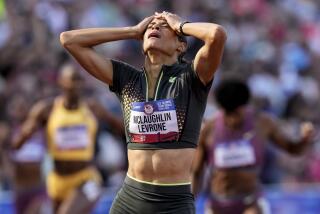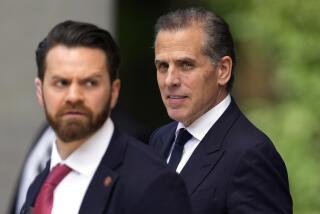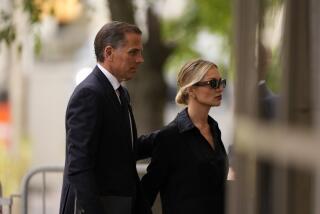Hunter Is Pleading Innocent
- Share via
SYDNEY, Australia — The International Olympic Committee’s drug chief announced today that C.J. Hunter, last year’s world shotput champion, had in recent months tested positive for the banned steroid nandrolone not once but four times. But Hunter tearfully said he had never knowingly ingested it.
Pausing frequently to dry his eyes, Hunter admitted knowingly taking only dietary supplements. After getting a kiss from his wife, Marion Jones--the U.S. track icon who is aiming for five gold medals at the Sydney Games--Hunter declared, “There’s nothing I could gain by taking that kind of risk. Nothing.”
A nutritionist who works with Hunter speculated that the manufacturer of the supplements--he did not name either the brand or the company--must also produce nandrolone and, because of “quality-control problems,” the nandrolone found its way into the packages of iron and calcium supplements that then made their way to Hunter’s table.
“If it was in the supplement, how would I know it was in the supplement?” Hunter asked at a news conference.
Jones, who won the gold medal Saturday in the women’s 100 meters in the first leg of her quest for five golds, offered “complete support for my husband,” who had qualified for the Sydney Games but pulled out on Sept. 11, eight days after undergoing arthroscopic knee surgery.
Then she kissed him and left.
The frenetic and tearful scene at the news conference underscored the drama that over the past two days has enveloped Hunter and Jones, as well as officials from the U.S. Olympic Committee, the International Olympic Committee and track and field’s worldwide governing body, the International Amateur Athletic Federation.
The capper was the appearance at the news conference of noted Los Angeles lawyer Johnnie Cochran Jr. Asked if he was on hand as counsel to either Jones or Hunter or to plan legal strategy for Hunter’s challenge of the nandrolone positives, he replied, “I’m here as a friend of the family.” Cochran’s association with Jones dates to 1992, when she was suspended by USA Track & Field for failing to show for a random drug test. He handled her case on appeal, arguing that neither she nor her coach had received notification of the test, and won.
Though Hunter, 31, said he intends to clear his name, he also said today he is retiring from the sport. “I don’t know what has happened but I can promise everybody I’m going to find out,” he said today.
An IAAF ban, if enforced, would last for two years.
USOC officials, meantime, said that Hunter--who is in Sydney to help coach his wife but had inadvertently been given an athlete’s credential for the Games--had turned in that pass.
The USOC said today it intended to immediately give him a “P” credential, which enables a coach to keep an athlete company at practice sessions, as well as tickets to her events. She begins qualifying Wednesday in the 200 meters and the long jump and is also due to compete in two relays.
Asked about Jones’ emotional outlook, Hunter told reporters, “What will affect Marion is battering by you guys.” Paparrazi in increasing number reportedly have been camping out at the suburban Sydney hotel where Jones and Hunter are staying.
The revelations involving Hunter and nandrolone mark merely the most high-profile of several doping controversies that are raging here--episodes that could hold far-reaching implications for the future of anti-doping campaigns and the Olympic movement.
Romania’s 16-year-old Andreea Raducan was stripped of her all-around gymnastics gold medal after testing positive for the banned stimulant pseudoephedrine. The team doctor who gave her the drug--in cold medicine pills--was expelled from the Games and suspended through the 2002 Winter Games in Salt Lake City and the 2004 Summer Games in Athens.
Raducan is the first gymnast to be stripped of a medal because of a drug violation. She is the second athlete at these games to lose a gold. Hers is also the sixth positive drug case at the Sydney Games.
Meantime, dozens of nandrolone positives involving athletes have been reported over the past several months. Some results have been overturned as athletes increasingly have claimed that they ingested the substance via supplements.
While officials crack down on nandrolone, meantime, Cuban high jumper Javier Sotomayor--who tested positive for cocaine--had his two-year ban cut so that he could compete at the Sydney Olympics. He won silver.
On Monday, the IAAF said Hunter had flunked one test “for a banned substance within [its] doping control system.”
Without naming a particular athlete, Belgium’s Prince Alexandre de Merode had told reporters earlier Monday that an athlete had tested positive for nandrolone at the Bislett Games in Oslo, a major international track meet in July.
The test, de Merode said, showed the presence of nandrolone, which helps athletes build strength and bulk, at 1,000 times the allowable limit.
Hunter said today he learned about that he was that athlete only on Monday, after reading reports in Sydney newspapers that he had tested positive. He recalled today what it was like to break the news to his wife: “I told her I don’t know what happened, and I’m sorry.”
Speaking to reporters, he said that he would never “do anything to jeopardize” his standing with his wife and family.
Today, De Merode, speaking informally to reporters at the IOC hotel, revised the total upward--saying Hunter had failed four separate tests this summer for steroid use. He said international and American track officials knew about these results and did not report them.
Full details of the other three tests--when they were taken, where they were analyzed, the levels of nandrolone they showed--were not immediately available.
Hunter said he had learned of these three tests while listening to the car radio en route to the news conference near downtown Sydney. At the same time, he offered specifics about two of the tests, saying one showed nandrolone limits 500 times over the permitted limit, the other 75 times.
De Merode said the tests were analyzed by IOC-accredited labs in Rome, Barcelona and Oslo, which filed coded results with the IOC and the IAAF.
The IAAF decoded the test results and informed USA Track & Field that Hunter had failed the tests, according to De Merode.
Officials of the IAAF and USATF could not be reached for comment. They consistently have defended themselves against prior allegations of cover-ups.
De Merode said the test results were found in files at the committee’s Swiss headquarters, adding that the IOC had become curious about similar findings it received during the summer as part of the lab accreditation process. It had no reason at the time, he said, to check the identity of the athlete.
The statements by De Merode were the latest by senior Olympic officials accusing the United States of a long history of covering up positive tests.
Craig Masback, CEO of USA Track & Field, defended the U.S. procedures Monday. He said the federation had conducted out-of-competition tests before any another sport and any other country.
“We’ve tested more people for more substances over a longer period of time,” he said. “And, unfortunately, we’ve busted more people than any other sport.
“Are we doing it perfectly? No, we’re not. But we have set the standard for the rest of the sports world. . . . I am far from being defensive about what we are doing. I am extremely proud of what we’ve done. We’ve been the leader in the world on this matter. We’ve paid a price for being the leader.”
He also noted that the focus on drugs--yet again--detracts from a track and field competition that has filled 110,000-seat Olympic Stadium for every night session.
“We should be here talking about the success of the athletes,” he said, sighing. “Not this issue.”
More to Read
Go beyond the scoreboard
Get the latest on L.A.'s teams in the daily Sports Report newsletter.
You may occasionally receive promotional content from the Los Angeles Times.






